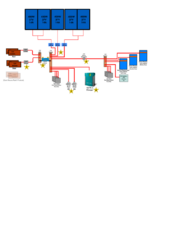SolarSail36
New Member
We are setting up solar panels and lithium batteries on our Lagoon 52. Overall, the plan is to start with 5 x 400 watt bifacials and 4 LiFe 460 Ah batteries (currently the boat has x6 210 Ah SLA and 360 w solar). I have a diagram (below) and a bunch of questions. Would love feedback, answers, and input.
- No. 1 from the Diagram: 200 A T-fuse for each pair - is that okay?
- No. 2 from the Diagram: The boat is configured with two parallel bus bars. I would like to bridge them with the smart shunt there instead of putting the smart shunt on negative, as all the batteries and all the other systems come together on one big negative bus bar. Will that work? Any issues? Show stoppers?
- No. 2 from the Diagram, again: would this be a good position for a 300 A kill switch?
- No. 3 from the Diagram: I assume all the MPPTs can be dropped right into the priority bus bar. Do these have to have a kill switch? Can it be a single switch for MPPT or does each one need their own? This would mean having to place a new bus bar for the MPPTs, however.
- No. 4 from the Diagram: The boat as configured has a 12 V kill switch in the saloon. This one gets quite warm and is a long run in and out of the salon. Is there a good way to upgrade this? One thought I had was to move the inverters to the priority bus but have a kill switch behind each one. This would decrease the current through that kill switch. Thoughts?
- No. 5 from the Diagram: The alternators are also tied to this priority bus. Given the change to LiPo I assume these will need to be disconnected?
- No. 6 from Diagram: The boat currently has a single Chargemaster 12/70-3. Obviously, not enough for LiPo, but we do want to keep it. However, how can I configure this for LiPo charging instead of SLA? The manual is not helpful.



